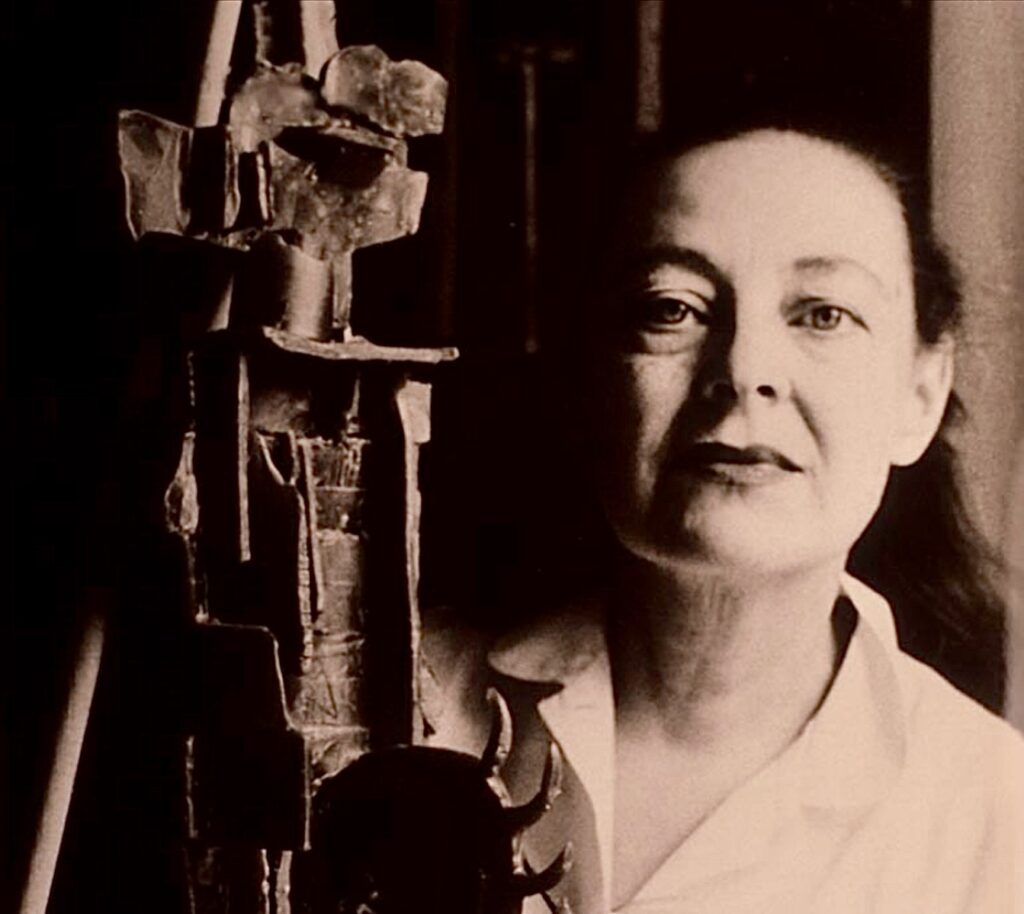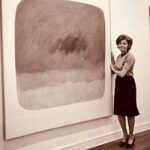Dorothy Dehner
Dorothy Dehner (1901-1994) was a multifaceted American artist whose work spanned sculpture, drawing, and printmaking. Known for her unique voice in abstract sculpture, Dehner’s career was marked by both personal and professional evolution. Her ability to synthesize a variety of influences into her own distinctive style has cemented her legacy as a significant figure in 20th-century American art.

Early Life and Education
Dorothy Dehner was born on December 23, 1901, in Cleveland, Ohio. Her early years were marked by frequent relocations due to her father’s job as an accountant. Tragically, Dehner’s parents died when she was young, leading her to live with relatives in Pasadena, California. This early period of instability likely contributed to her resilience and determination in later life.
Dehner’s interest in art began at a young age. She initially pursued acting and attended the University of California, Los Angeles, where she studied drama. However, her interest in visual arts soon took precedence. In 1925, she moved to New York City to study at the Art Students League, where she was exposed to a wide array of artistic styles and techniques.
Early Artistic Career and Personal Life
At the Art Students League, Dehner studied under influential artists such as Kenneth Hayes Miller and Jan Matulka. Her early work was primarily focused on painting and drawing, with a strong influence from the European avant-garde. During this time, she met and married sculptor David Smith in 1927. Their relationship was both a personal and professional partnership, with Smith’s work significantly influencing Dehner’s own artistic development.
The couple moved to Bolton Landing in upstate New York in 1940, where they established a studio. Dehner’s early works from this period were largely overshadowed by her husband’s burgeoning career. However, she continued to develop her own voice, experimenting with various media and styles.
Transition to Sculpture
It wasn’t until the late 1940s, following her separation from Smith, that Dehner fully committed to sculpture. This period marked a significant turning point in her career. Freed from the constraints of her marriage, Dehner was able to explore her own artistic vision more deeply. She began to create abstract sculptures that combined elements of Cubism, Surrealism, and Constructivism.
Dehner’s sculptures were characterized by their intricate, interlocking forms and a sense of dynamic movement. She often used bronze and wood, materials that allowed her to experiment with texture and form. Her work from this period reflected her interest in nature, mythology, and personal experience, themes that would continue to resonate throughout her career.
Artistic Recognition and Influence
Dehner’s work began to gain recognition in the 1950s, with exhibitions at prominent galleries and museums. She was associated with the New York School, a group of artists known for their abstract expressionist works. Despite this association, Dehner’s sculptures stood out for their distinct approach to form and space.
Her work was included in important exhibitions such as the Whitney Annual and the Sculpture Annual at the Whitney Museum of American Art. These exhibitions helped to establish her reputation as a significant sculptor in her own right, separate from her association with David Smith.
Important Artwork: “Homage to Marcel Duchamp” (1966)
One of Dorothy Dehner’s most significant works is “Homage to Marcel Duchamp” (1966). This sculpture exemplifies her ability to blend various influences into a cohesive and compelling piece.
“Homage to Marcel Duchamp” (1966)
“Homage to Marcel Duchamp” is a bronze sculpture that stands approximately 24 inches tall. The work is composed of a series of interlocking geometric shapes that create a sense of balance and tension. The title of the piece pays tribute to Marcel Duchamp, a pioneering figure in modern art known for his conceptual approach and use of readymade objects.
In “Homage to Marcel Duchamp,” Dehner uses abstraction to explore themes of transformation and movement. The sculpture’s geometric forms are arranged in a way that suggests both stability and fluidity. The interplay of light and shadow on the bronze surface adds to the work’s dynamic quality, inviting viewers to engage with it from multiple angles.
The influence of Duchamp is evident in Dehner’s use of abstract forms to challenge traditional notions of sculpture. However, the work also reflects her unique vision and ability to synthesize different artistic influences. The sculpture’s intricate composition and attention to detail demonstrate Dehner’s technical skill and her deep understanding of form and space.
“Homage to Marcel Duchamp” is a testament to Dehner’s ability to create works that are both intellectually engaging and visually compelling. The sculpture’s exploration of abstraction and its tribute to a key figure in modern art highlight Dehner’s place within the broader context of 20th-century sculpture.
Later Career and Legacy
Throughout the 1970s and 1980s, Dorothy Dehner continued to create innovative and thought-provoking works. She remained active in the art world, participating in exhibitions and teaching at various institutions. Her later works often reflected a more introspective approach, exploring themes of memory, identity, and personal experience.
Dehner’s contributions to the field of abstract sculpture were recognized with numerous awards and honors. In 1983, she received the prestigious Lifetime Achievement Award from the Women’s Caucus for Art. Her work is included in the collections of major museums, including the Metropolitan Museum of Art, the Museum of Modern Art, and the Smithsonian American Art Museum.
Dehner’s influence extends beyond her own body of work. As a female artist who achieved recognition in a male-dominated field, she paved the way for future generations of women sculptors. Her commitment to exploring new forms and materials continues to inspire artists today.
Personal Life and Philosophy
Dorothy Dehner’s personal life was marked by both triumph and tragedy. Her marriage to David Smith was a significant influence on her early career, but it was also a source of personal and professional challenges. Despite these difficulties, Dehner remained committed to her artistic vision and continued to create powerful and innovative works.
Dehner’s approach to art was characterized by a sense of curiosity and experimentation. She believed in the importance of pushing boundaries and exploring new possibilities. Her work reflects a deep engagement with the world around her, from the natural landscape of Bolton Landing to the broader cultural and artistic currents of her time.
Conclusion
Dorothy Dehner’s artistic journey is a testament to her resilience, creativity, and dedication to the practice of sculpture. Through her innovative use of materials and her exploration of form and space, Dehner created a body of work that continues to resonate with viewers and artists alike. Her notable work, “Homage to Marcel Duchamp,” exemplifies her ability to create dynamic and intellectually engaging compositions.
In celebrating Dorothy Dehner’s life and work, we recognize her significant contributions to the development of abstract sculpture and her enduring legacy as a trailblazer in American art. Her sculptures remain powerful and evocative, reminding us of the potential of art to engage with the human condition and the world around us.



